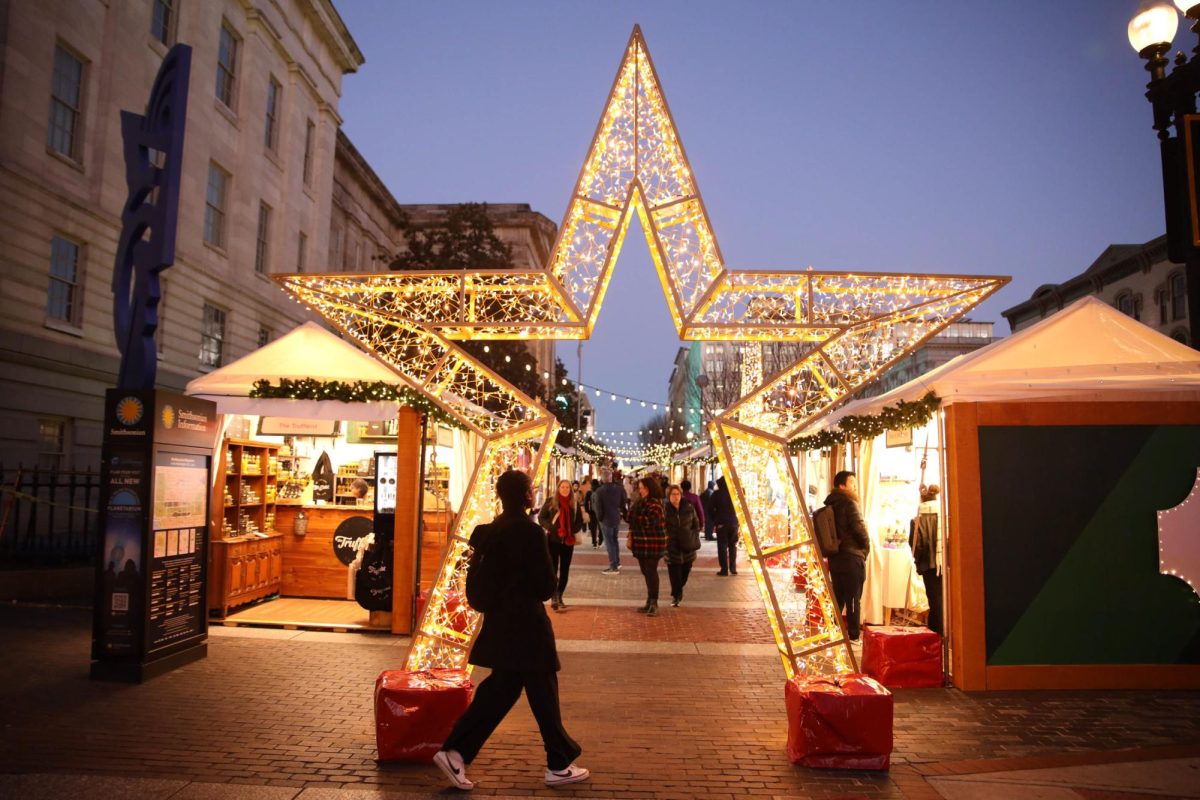Students taking a walk to the National Mall may have a run-in with Gilbert Stuart’s famous portrait of George Washington, which gazes at the city from a bus stop on Pennsylvania Avenue between 9th and 10th streets NW.
The painting joins 57 other iconic American works on public display this month in metropolitan areas across the country, including the District, as part of the “Art Everywhere” campaign. A joint effort between the Outdoor Advertising Association of America and five major art museums, the campaign places art reproductions on thousands of bus stops, billboards and other public spaces.
Many displays are just a short walk from campus. Both Grant Wood’s 1930 work “American Gothic” and Andy Warhol’s iconic 1964 “Campbell’s Soup Can” are printed on bus shelters at 18th and K streets and Pennsylvania Avenue and 14th Street, respectively.
The art drive, which Art Everywhere calls the “largest outdoor art show ever conceived,” aims to bring works from museum walls into the daily lives of ordinary Americans. Nicole Hayes, a spokeswoman for the Outdoor Advertising Association of America, said the campaign targets people who may never have a chance to see the works in a museum.
“Museums are now above them as they drive to work, or in the insides of the bus that they commute in, or in the Metro, you know, as they get out and go about their day,” Hayes said.
The campaign will complete its first month-long exhibition Sunday. And with just a handful of days left to see the art, the campaign is exploding on social media with thousands of Instagram posts, tweets and Facebook posts from art enthusiasts across the U.S. as they track down each public display.
“It’s a bit of a treasure hunt, if you will. We have people that are posting, ‘I found one here,’ ‘Oh, I found one at the intersection of 18th and K’ or ‘I found one at the Fort Totten Metro,’” Hayes said.
Caranine Smith, the director of GW’s Gallery 102, said modern technology may be what allows movements like Art Everywhere to build up a following.
“It is technology that is driving interactions with art, whether it’s through individuals accessing art and information online, artists creatively utilizing new technologies and connecting and sharing ideas or the organization or launching and promotion of large-scale campaigns such as Art Everywhere,” she said.
The National Gallery of Art, one of the five museums the Outdoor Advertising Association of America tapped to provide works for Art Everywhere, is home to more pieces displayed in the campaign than any other: 14 of the total 58 works came from the museum located on the Mall.
Deborah Ziska, a spokeswoman for the National Gallery, said choosing which works to nominate for the project was easy. The museum, after all, is known for its renowned collection of 18th- and 19th-century American art, she said.
The harder part was considering more technical elements, like choosing pieces that would reproduce well, and making sure all major genres of art were featured.
“We had to think of all the factors and what would resonate beyond the marble walls. So sometimes there are important works that just don’t reproduce very well,” Ziska said.
Charles Brock, the museum’s associate curator of American paintings, said he thinks the museum’s two most influential American works are Winslow Homer’s “Breezing Up,” (1876) which depicts three boys on a boating trip, and Thomas Moran’s western landscape, “Green River Cliffs, Wyoming” (1881).
Both were included in the campaign’s final 58, and students, residents and visitors can find them across D.C.
“In a way they’re both about horizons, they’re both about a sense of America’s destiny in some way. It’s interesting to think about those types of images being transposed to all these very different places all over the country,” Brock said.
After the success of the movement’s first exhibition, Ziska hopes the National Gallery will participate again next year, calling the campaign an interactive and stimulating way to educate Americans about their own history while cultivating an interest in the arts.
“In one way, these paintings tell a lot of different perspectives and stories of the American experience, so people can learn about or understand our common heritage in different ways,” Ziska said.
Artwork on display near campus:
“My Egypt” by Charles Demuth (1927)
18th and I streets
Provided by the Whitney Museum of American Art
“American Gothic” by Grant Wood (1930)
K Street between 18th and 19th streets
Provided by the Art Institute of Chicago
“Allies Day” by Childe Hassam (1917)
Pennsylvania Avenue and 22nd Street
Provided by the National Gallery of Art
“Campbell’s Soup Can” by Andy Warhol (1964)
Pennsylvania Avenue and 14th Street
Provided by the Los Angeles County Museum of Art
“Phil” by Chuck Close (1969)
New York Avenue and 12th Street
Provided by the Whitney Museum of American Art
“George Washington” by Gilbert Stuart (1821)
Pennsylvania Avenue and 10th Street
Provided by the National Gallery of Art







